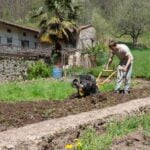How much water do vegetable gardens need? Understanding the water requirements of your vegetable garden is crucial for the health and productivity of your plants. Proper watering plays a significant role in ensuring that your vegetables thrive, produce abundant yields, and resist diseases. In this article, we will delve into the factors that influence water needs in vegetable gardens, including plant type, soil composition, climate conditions, and seasonal variations.
Different types of plants have varying water requirements, with some needing more frequent watering than others. The type of soil in your garden also affects how much water your vegetables need, as sandy soils drain faster while clay soils retain moisture longer.
In addition, the climate and time of year play a significant role in determining when and how much you should water your vegetable garden. By understanding these factors, you can tailor your watering practices to meet the specific needs of your plants.
Overwatering and underwatering are common issues that can harm your vegetable garden. Signs like yellowing leaves, wilting plants, or root rot indicate that your plants are not receiving the right amount of water. It is essential to be able to identify these symptoms early on to adjust your watering routine accordingly. In the following sections, we will explore best practices for watering vegetable gardens, including tips on frequency, timing, and methods to help you maintain a healthy and thriving garden.
Factors That Influence Water Needs in Vegetable Gardens
Watering your vegetable garden is crucial for the health and productivity of your plants. But determining how much water your vegetable garden actually needs can be a bit tricky. Several factors come into play when calculating the water requirements for your vegetable garden, including the type of plants you are growing, the soil type in your garden, the climate of your region, and the current season.
The type of plant you are growing plays a significant role in how much water it needs. Some vegetables, like tomatoes and cucumbers, require more water than others. Leafy greens such as lettuce and spinach also have high water needs. On the other hand, root vegetables like carrots and radishes require less frequent watering. Understanding the specific water requirements of each type of plant in your vegetable garden is essential to ensure they thrive.
Another factor that influences how much water your vegetable garden needs is the type of soil present in your garden. Sandy soils drain quickly and may require more frequent watering, while clay soils retain moisture longer but may become waterlogged if overwatered.
Amending your soil with organic matter can help improve its water retention capabilities and ensure that your plants receive adequate moisture throughout the growing season. Additionally, incorporating mulch around your plants can help conserve soil moisture and reduce evaporation.
The climate and season also impact the water needs of your vegetable garden. Hotter temperatures increase evaporation rates, leading to higher water requirements for your plants during summer months. In contrast, cooler temperatures or rainy weather may necessitate less frequent watering. Monitoring weather patterns in your area and adjusting your watering schedule accordingly is key to ensuring that your vegetable garden receives the right amount of water to thrive.
Identifying Signs of Overwatering and Underwatering in Vegetable Gardens
Overwatering and underwatering are common issues that can impact the health of vegetable gardens. It is crucial for gardeners to be able to identify the signs of these problems in order to adjust their watering practices accordingly. Here are some key symptoms to look out for:
- Yellow Leaves: One of the most noticeable signs of overwatering in vegetable plants is yellowing leaves. This can be caused by root suffocation due to waterlogged soil, which prevents proper nutrient uptake.
- Wilting: While wilting is often associated with plants needing more water, it can also indicate overwatering. Overly wet soil restricts oxygen flow to the roots, leading to wilting despite sufficient moisture.
- Root Rot: Overwatering creates a favorable environment for root rot pathogens to thrive. If plants display mushy or discolored roots, it is likely a result of too much water in the soil.
On the other hand, underwatering can also cause detrimental effects on vegetable gardens if not addressed promptly. Some symptoms of underwatering include:
- Drooping Leaves: Just like with overwatering, wilting can be a sign of underwatered plants. Lack of water hinders the plant’s ability to maintain turgidity, resulting in droopy leaves.
- Browning and Crisping: Insufficient water supply causes plant tissues to dry out and die, leading to browning and crisping of leaves. This can progress quickly if adequate hydration is not provided.
- Stunted Growth: When plants do not receive enough water, their growth may become stunted as they struggle to photosynthesize and produce new tissue. This can significantly impact yield and overall plant health.
By learning to recognize these telltale signs of overwatering and underwatering, gardeners can adjust their watering routines accordingly and ensure that their vegetable gardens thrive with just the right amount of moisture.
Best Practices for Watering Vegetable Gardens
Watering Frequency
Determining the ideal watering frequency for your vegetable garden can vary depending on various factors such as plant type, soil type, climate, and season. As a general rule of thumb, most vegetable gardens require about 1 inch of water per week, either from rainfall or supplemental irrigation. However, during hot and dry periods, you may need to water more frequently to ensure your plants are getting enough moisture to thrive.
It is essential to monitor the soil moisture levels regularly by checking the top few inches of soil. If it feels dry to the touch, it’s time to water.
Time of Day
The timing of watering your vegetable garden can also impact the effectiveness of watering. It is recommended to water your garden early in the morning or late in the evening when temperatures are cooler and evaporation rates are lower.
Watering during these times helps minimize water loss due to evaporation and allows the plants to absorb moisture more efficiently. Avoid watering during the middle of the day when the sun is at its peak as this can lead to water loss through evaporation before it reaches the plant roots.
Methods of Watering
There are various methods of watering that you can use for your vegetable garden, each with its own advantages and disadvantages. Hand watering with a watering can or hose nozzle allows you to target specific plants that may need extra attention or avoid wetting foliage susceptible to diseases. Drip irrigation systems provide a slow and consistent supply of water directly to the root zone, promoting deeper root growth and conserving water.
Soaker hoses are also effective at delivering water slowly along their length, reducing runoff and minimizing evaporation. Choose a watering method that suits your garden layout, plant needs, and personal preferences for optimal results in maintaining healthy vegetable crops.
Watering Tools for Vegetable Gardens
Soaker Hoses
Soaker hoses are an efficient tool for watering vegetable gardens as they deliver water directly to the base of plants, reducing waste from evaporation and runoff. These hoses are porous, allowing water to seep out slowly and deeply into the soil, promoting healthy root growth. By placing soaker hoses along the rows or around individual plants, gardeners can ensure that roots receive a consistent supply of moisture without wetting the foliage, which can lead to disease.
Drip Irrigation
Drip irrigation systems are another excellent option for effectively watering vegetable gardens. These systems consist of tubing with emitters that release water directly to the root zone of plants.
Drip irrigation not only conserves water by minimizing evaporation and runoff but also helps prevent issues like leaf burn and fungal diseases by keeping foliage dry. With adjustable settings for flow rate and scheduling, gardeners can tailor their drip irrigation system to meet the specific water needs of different types of vegetables in their garden.
Watering Cans
While soaker hoses and drip irrigation systems offer convenience and efficiency, watering cans remain a simple yet effective tool for spot-watering in vegetable gardens. Watering cans allow gardeners to target individual plants or areas that may require more attention, especially during dry spells or when establishing newly transplanted seedlings.
By using a watering can with a fine rose attachment for gentle watering, gardeners can avoid splashing soil onto leaves and ensure that water reaches the roots where it is needed most.
Calculating Water Needs for Vegetable Gardens
Calculating the water needs for your vegetable garden is crucial in ensuring that your plants thrive and produce a bountiful harvest. The amount of water required can vary depending on factors such as plant type, soil type, climate, and the season. To determine how much water your vegetable garden needs, you can use a simple formula based on these key factors.
One common method to calculate water needs for specific plants is to consider the plant’s water requirements based on its growth stage. For example, seedlings and young plants generally need more frequent watering compared to established plants. A general guideline is to provide about 1 inch of water per week through rain or irrigation for most vegetables. However, this amount can vary depending on weather conditions and soil moisture levels.
It is important to monitor soil moisture regularly by checking the depth of moisture penetration with a finger or a trowel. Additionally, investing in a rain gauge can help you keep track of rainfall amounts so you can adjust your watering schedule accordingly. By understanding the specific water requirements of your vegetable plants and using these formulas and guidelines, you can ensure that your garden receives the right amount of hydration for optimal growth and yield.
| Plant Type | Watering Frequency |
|---|---|
| Lettuce | Every other day |
| Tomatoes | 2-3 times per week |
| Zucchini | Once a week |
Water Conservation in Vegetable Gardens
Water conservation is a critical aspect of maintaining a sustainable and thriving vegetable garden. By implementing mindful practices, gardeners can reduce water waste and promote the overall health of their plants. Here are some effective ways to conserve water in your vegetable garden:
- Utilize Mulching: Mulching is a simple yet effective technique to retain moisture in the soil and reduce evaporation. Organic mulches like straw, wood chips, or compost can help regulate soil temperature and prevent water loss due to evaporation.
- Implement Rainwater Harvesting: Collecting rainwater can be an excellent way to supplement your watering needs without relying solely on treated water sources. Install rain barrels or a rainwater harvesting system to capture runoff from your roof for later use in watering your vegetable garden.
- Choose Drought-Tolerant Plants: Opting for plant varieties that are well-adapted to dry conditions can significantly decrease the amount of water needed in your garden. Drought-tolerant plants have evolved mechanisms to survive with minimal water, making them ideal choices for conserving water resources.
By incorporating these water conservation practices into your vegetable garden routine, you can not only save resources but also promote the sustainability of your gardening efforts.
It is essential for gardeners to be mindful of their water usage and make conscious decisions in managing their vegetable gardens’ hydration needs. By understanding how much water do vegetable gardens need based on factors like plant type, soil type, climate, and season, individuals can tailor their watering routines accordingly.
Investing time and effort into proper water management will not only benefit the health and growth of your plants but also contribute to environmental sustainability in the long run.
Case Studies
Growing a successful vegetable garden requires proper watering techniques to ensure that your plants thrive and produce an abundant harvest. One of the primary questions many gardeners ask is, “How much water do vegetable gardens need?” The answer varies depending on several factors, including plant type, soil composition, weather conditions, and the time of year. Understanding these variables is key to providing your garden with the right amount of water to keep it healthy and productive.
Different vegetables have different water requirements. For example, leafy greens like lettuce and spinach typically need more frequent watering than root crops such as carrots or beets. In general, most vegetable plants require about 1-2 inches of water per week through a combination of rainfall and irrigation.
However, during hot summer months or in sandy soil that drains quickly, you may need to increase this amount. Monitoring the moisture levels in your soil and observing your plants for signs of stress can help you determine if they are getting enough water.
To accurately gauge how much water your vegetable garden needs, consider investing in a rain gauge to track rainfall amounts and a soil moisture meter to measure the hydration levels in your garden beds. Keeping a watering schedule based on the specific needs of your plants and adjusting it according to weather patterns can help prevent both overwatering and underwatering.
Additionally, using mulch around your plants can help retain soil moisture and reduce evaporation, ensuring that your vegetables receive consistent hydration throughout the growing season.
| Vegetable Type | Water Requirement |
|---|---|
| Lettuce | High; frequent watering needed |
| Carrots | Moderate; consistent moisture required |
| Tomatoes | Regular; deep watering essential for fruit development |
Conclusion
In conclusion, understanding how much water vegetable gardens need is essential for maintaining healthy and thriving crops. By considering factors such as plant type, soil type, climate, and season, gardeners can tailor their watering habits to meet the specific needs of their plants. Recognizing the signs of overwatering and underwatering, such as yellow leaves, wilting, and root rot, is crucial in adjusting watering practices accordingly.
Implementing best practices for watering vegetable gardens, including watering frequency, time of day, and methods like soaker hoses or drip irrigation systems, can help conserve water while promoting optimal plant growth. Calculating water needs accurately based on specific formulas and guidelines ensures that plants receive just the right amount of moisture they require to flourish. Water conservation techniques like mulching, rainwater harvesting, and selecting drought-tolerant plants also play a vital role in sustainable gardening practices.
Through case studies showcasing successful vegetable gardens with efficient watering strategies and the positive outcomes of proper water management techniques, it becomes evident that investing time and effort into ensuring adequate hydration for plants yields rewarding results. Ultimately, by practicing responsible water management in vegetable gardens, gardeners not only promote healthier crops but also contribute to environmental sustainability by conserving this precious resource for future generations.
Frequently Asked Questions
Should I Water My Vegetable Garden Every Day?
Watering your vegetable garden every day may not be necessary and could actually do more harm than good. Overwatering can lead to root rot and other issues that can damage the plants. It’s best to water your garden when the soil is dry about an inch below the surface.
Am I Watering My Vegetables Too Much?
If you suspect you are watering your vegetables too much, it’s important to assess the soil and plant conditions. Overwatering can lead to waterlogged soil, which deprives roots of oxygen and causes plants to wilt. Check the soil moisture level before watering again.
Should I Water My Garden Every Day in Hot Weather?
In hot weather, it’s crucial to pay attention to the watering needs of your garden, but daily watering may not always be necessary. Hot weather can cause water to evaporate quickly, so it’s important to monitor soil moisture levels and adjust your watering schedule accordingly. Consider using mulch to retain moisture in the soil.

If you’re looking to get into vegetable gardening, or are just looking for some tips on how to make your current garden better, then you’ve come to the right place! My name is Ethel and I have been gardening for years. In this blog, I’m going to share with you some of my best tips on how to create a successful vegetable garden.





